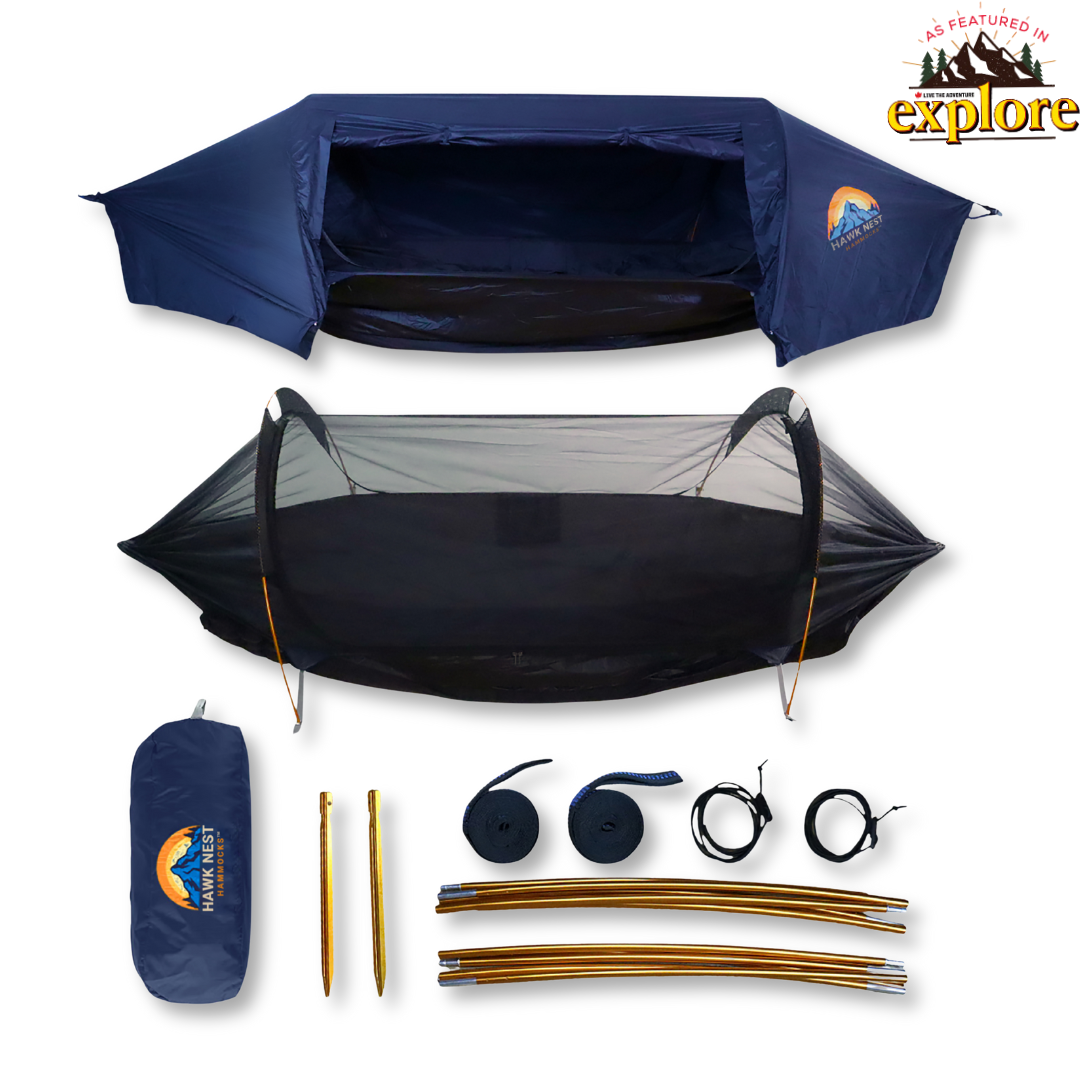Table of Contents
- Introduction to Hammock Tent Camping
- Choosing the Right Hammock Tent
- Setting Up Your Hammock Tent
- Advanced Hammock Tent Features and Accessories
- FAQs and Conclusion
Introduction to Hammock Tent Camping
Welcome to the tranquil world of hammock tents, where camping meets comfort in the heart of nature. A hammock tent combines the lightweight versatility and comfort of a hammock with the protective enclosure of a tent. This innovative camping gear is designed to elevate your outdoor experience, literally and figuratively, by suspending you above the ground for a peaceful sleep.
What is a Hammock Tent?
A hammock tent is essentially a hammock integrated with a cover that protects against the elements, much like a tent. It's designed to be attached between two trees or sturdy points, offering a floating abode that keeps you away from ground-based annoyances like dampness, uneven terrain, and crawling insects.
Benefits of Using a Hammock Tent in Canada
-
Enhanced Comfort: Unlike traditional tents, hammock tents conform to your body shape, providing a unique sleeping experience that reduces pressure points.
-
Versatile Setup: Whether deep in the forest or overlooking a mountain vista, hammock tents can be set up anywhere you find strong trees, giving you a front-row seat to nature’s beauty.
-
Minimal Environmental Impact: Elevated above the ground, these tents minimize the ecological footprint left on the natural terrain, preserving the pristine condition of your campsite.
-
Portability and Lightness: Hammock tents are lighter than most traditional tents and are compact enough to be included in a backpack, making them ideal for backpackers and through-hikers.
Exploring the Canadian wilderness in a hammock tent not only provides comfort and convenience but also connects you more intimately with the environment. The gentle sway of the hammock lulls you into relaxation, offering a serene escape from the hectic pace of daily life.
As we delve deeper into the world of hammock tent camping, upcoming sections of this blog will guide you on how to select the right hammock tent, set it up efficiently, and make the most out of its features and accessories. Stay tuned to transform your outdoor adventures with the innovative hammock tent, a true game-changer in wilderness camping.

Choosing the Right Hammock Tent
Selecting the ideal hammock tent involves understanding the specific features that will enhance your outdoor adventures. Here, we'll guide you through the factors to consider and highlight some of the top models available on the market.
Factors to Consider: Material, Weight, and Durability
Material: The choice of material is crucial as it dictates both the durability and weather resistance of your hammock tent. Opt for hammock tents made from high-quality nylon or polyester with ripstop technology to prevent tears. Additionally, a waterproof coating is vital for weather protection.
Weight: The weight of the hammock tent is an important consideration, especially for backpackers. A lightweight tent will be easier to carry on long hikes without sacrificing strength or comfort. The weight should align with the type of camping you plan on doing.
Durability: Durability is determined by the quality of materials used and the construction of the tent. Look for double stitching, reinforced stress points, and heavy-duty zippers as indicators of a well-made hammock tent that can withstand various elements and frequent use.
Hammock Tent Vs. Ground Tent Comparison

Top Hammock Tent Brands and Models
Exploring different brands and models helps in making an informed choice that suits your camping style and needs. Here are a few recommended options:
-
Hawk Nest Hammocks: Known for their robust construction and ease of use, Hawk Nest Hammocks offer models that are perfect for both novice campers and seasoned outdoorsmen. Their tents are designed to provide a balance of comfort, durability, and portability.
-
Haven Tents: Haven Tents stand out with their unique design that allows for a flat sleeping surface, significantly advantageous for those who find traditional hammock curves uncomfortable. They also feature integrated bug nets and rainflys, making them ideal for all-weather conditions.
-
Hennessy Hammocks: These are well-regarded for their durability and comfort. Hennessy's designs include features like asymmetrical shape for a more natural sleep position, strong materials, and protective features against insects and weather.
The Hawk Nest Hammock Tent
| Feature | Description | Benefits |
|---|---|---|
| Material | High-quality ripstop nylon | Durable, lightweight, waterproof |
| Setup | Integrated suspension system | Easy and quick to install |
| Portability | Compact and lightweight design | Perfect for backpacking and hiking |
| Comfort | Ergonomic sleeping position | Enhances sleep quality, reduces back pain |
| Environmental Impact | No ground contact | Minimizes disturbance to the natural site |
Choosing the right hammock tent will significantly enhance your camping experience by providing comfort, protection, and peace of mind as you explore the great outdoors. Remember, the best hammock tent for you is one that suits your specific outdoor activity needs while offering the best balance of durability, comfort, and weight.
Setting Up Your Hammock Tent
Setting up a hammock tent is a straightforward process that can significantly enhance your outdoor experience. With a few simple steps, you can create a comfortable and secure resting spot between two trees, allowing you to enjoy the beauty of your surroundings from a unique vantage point.
Step-by-Step Guide on Installation
Choosing the Right Location: The first step in setting up your hammock tent is to find two sturdy trees or anchors that are appropriately spaced. Ideally, the trees should be about 12 to 15 feet apart and strong enough to support your weight. Make sure there are no sharp branches or hazards overhead.
Hanging the Suspension System: Most hammock tents come with a suspension system, which may include straps and carabiners. Wrap the straps around each tree and secure them according to the manufacturer’s instructions. It’s important to ensure that the straps are flat against the tree to prevent slipping and damage to the tree bark.
Attaching the Hammock: Once the straps are in place, attach your hammock tent to the straps using the carabiners or other provided mechanisms. Adjust the height and tension to your comfort. The ideal height for a hammock tent is about 18 inches off the ground, allowing for easy entry and exit while ensuring you won’t touch the ground when the hammock sags under your weight.
Setting Up the Rainfly: If your hammock tent comes with a rainfly, attach it above the hammock. Ensure it is taut and covers the hammock completely to provide protection from rain and dew. Adjust the positioning to shield against prevailing winds or to maximize airflow, depending on the weather.
Securing the Bug Net: If your setup includes a bug net, drape it over the hammock and secure it to the ground using stakes, or attach it to the same trees as your hammock. Make sure the net is sealed to keep insects out effectively.
Tips for Choosing the Best Location
-
Look for Level Ground: While your hammock will be suspended, choosing a spot over level ground is safer and makes it easier to get in and out of the hammock.
-
Avoid Dead Trees: Always inspect the trees for health. Avoid dead or diseased trees, as they can fail under weight or in windy conditions.
-
Consider the Environment: Be mindful of your impact on the surroundings. Practice Leave No Trace principles by using tree-friendly straps and minimizing your footprint.
Setting up a hammock tent is more than just finding two trees; it’s about creating a comfortable, safe, and environmentally conscious campsite. With these steps, you can enjoy the numerous benefits of hammock camping, whether you're looking up at the stars or waking up to a sunrise over the hills.
Advanced Hammock Tent Features and Accessories
Enhancements for Comfort and Convenience
Upgrading your hammock tent with the latest advancements in camping technology can significantly enhance both comfort and functionality. Modern hammock tents are not just about sleeping off the ground—they come equipped with features that offer unprecedented comfort and utility. For instance, integrated insulation systems help keep campers warm in colder climates, extending the usability of hammock tents into the cooler seasons. Adjustable suspension systems, like those found in Hawk Nest Hammocks, offer easier and more reliable setup options, critical after a long day of hiking.
Must-Have Accessories for the Ultimate Hammock Tent Experience
To truly maximize your hammock tent experience, certain accessories are indispensable. A high-quality rain tarp is essential for protection against the elements, while robust bug netting can make the difference between a good night's sleep and a night spent swatting at mosquitoes. Additionally, underquilts and sleeping pads designed for hammock use can provide extra warmth and comfort, essential for cooler temperatures. Look for hammocks that have a built in pocket for your sleeping pad to keep it from sliding around which can ruin your sleep! A gear loft is perfect for keeping essentials handy and organized, and eco-friendly stakes and guy lines ensure safety and sustainability.
Integrating these features and accessories into your hammock tent setup not only enhances your comfort but also ensures you are prepared for a wide range of environments and conditions. Whether you're a seasoned backpacker or a weekend warrior, these enhancements are designed to improve your overall camping experience, allowing you to relax and enjoy the natural beauty around you.

FAQs and Conclusion
As we wrap up our comprehensive guide on hammock tents, let's address some frequently asked questions that may help you better understand the versatility and functionality of hammock tents:
- Are Hammock Tents Comfortable? Yes, hammock tents are designed for comfort. They often include features like flat sleeping surfaces, insulation systems, and protective bug nets and rainflies. These elements enhance the comfort levels over traditional hammocks, making them suitable for a variety of camping conditions.
- Can Hammock Tents be Used in Cold Weather? While hammock tents provide less insulation than traditional tents, with the right setup—including an underquilt, top quilt, and appropriate sleeping pad—you can enjoy hammock camping even in colder conditions. It's crucial to be prepared for temperature drops and consider additional protective gear to retain warmth.
- What Should I Consider When Choosing a Hammock Tent? Key factors include the weight capacity, the quality of materials like rip-stop nylon, ease of setup, and whether it includes essential accessories like rainflies and bug nets. Consider the specific conditions you anticipate facing, such as wind and rain, and ensure the hammock tent is equipped to handle them.
- Are Hammock Tents Suitable for All Camping Locations? The suitability of hammock tents depends on the availability of strong anchor points, typically trees. For areas with sparse vegetation or where tree camping is prohibited, traditional tents might be a better option. Always evaluate the environment of your campsite before deciding on the best shelter.
- How Do Hammock Tents Compare to Traditional Tents? Hammock tents offer a unique experience compared to traditional ground tents. They are elevated off the ground, which can provide a more comfortable sleep and a reduced impact on the ground environment. However, they require trees for setup and can be more exposed to the elements without the proper setup.
For more detailed insights and reviews on specific models, exploring resources like Outdoorsman Toolkit and Tent Camping Trips can provide additional guidance on selecting and using hammock tents effectively. These platforms offer a wealth of information on various models and setups, helping you make the best choice for your camping needs.
Remember, choosing the right hammock tent is about balancing your needs with the features available. Whether you're looking for a lightweight option for backpacking or a more robust model for family camping, there's a hammock tent out there that's perfect for your next adventure.
If you are interested in getting your own hammock tent, you can checkout our Hawk Nest All-Season Hammock Tent, or checkout our homepage.


